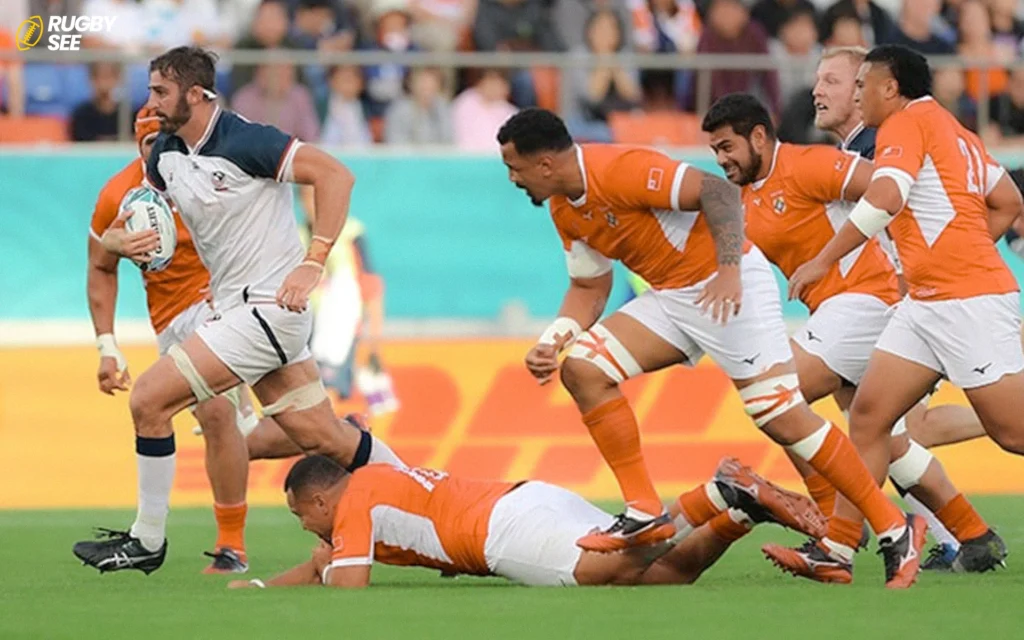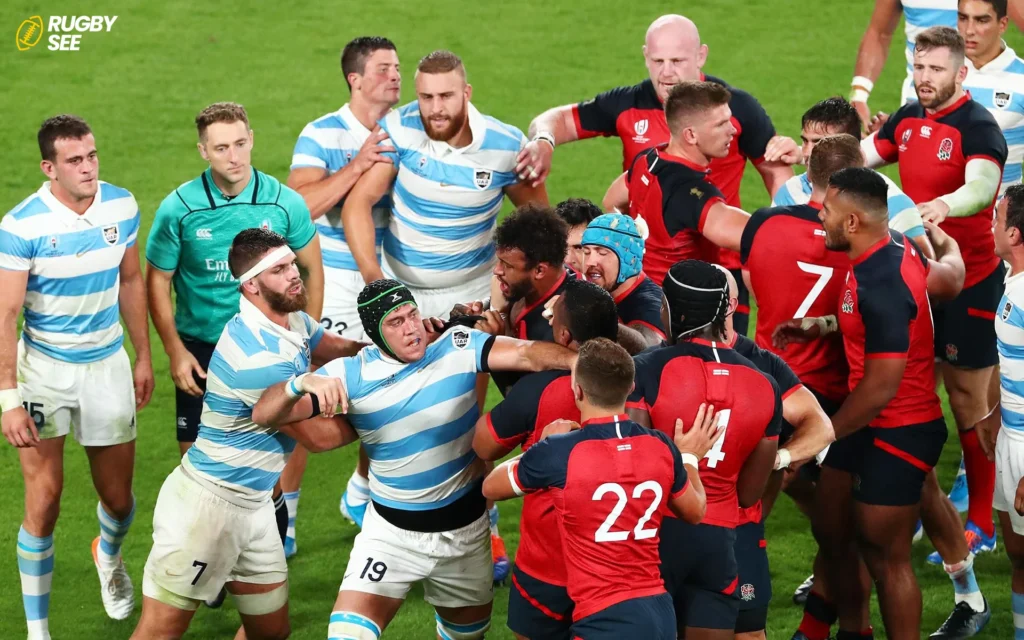In the rugged and exhilarating world of rugby, every piece of gear and apparel serves a purpose, contributing to both the performance and safety of the players. Among the various elements of a rugby player’s attire, what they wear on their backs has piqued the curiosity of many fans and aspiring athletes. This article aims to shed light on this aspect, delving into the practicality and necessity behind the gear that adorns the backs of rugby players.
The Rugby Jersey: More Than Just a Number
The most prominent item rugby players wear on their backs is their jersey. But these are not just any jerseys; they are crafted to withstand the tough, grappling nature of the sport. Made from durable, stretchable fabrics like polyester, they are designed to endure pulling and tugging during a game. The numbers printed on the back are not merely for identification; they signify the player’s position, role, and responsibilities on the field, making it easy for coaches, referees, and spectators to follow the game.
GPS Trackers: The High-Tech Addition
In recent years, the introduction of GPS tracking devices has revolutionized how coaches and medical teams monitor player performance and well-being. These small, lightweight devices are often sewn into a pouch or pocket on the back of the player’s jersey. They collect data on the player’s movements, speed, distance covered, heart rate, and more, providing invaluable insights into their physical condition and the demands of their role during the game. This technology allows for real-time monitoring and post-game analysis, aiding in strategy development and injury prevention.

Protective Gear: Combining Safety with Performance
Another critical component that players wear on their backs is protective padding. Unlike the bulky pads seen in American football, rugby pads are slim and flexible, designed to offer protection without compromising mobility. These pads typically cover key areas such as the shoulders, spine, and sometimes the ribs, providing a layer of defense against the impacts and abrasions common in the sport. The design of these pads is carefully regulated to ensure they do not excessively increase a player’s body mass or impact the game’s natural flow.
The Evolution of Rugby Back Gear
The evolution of what rugby players wear on their backs reflects broader trends in sports science and technology. From the simple, cotton jerseys of the past to today’s high-tech, performance-enhancing gear, every change has been aimed at improving the sport’s safety and competitiveness. This evolution is ongoing, with manufacturers continually exploring new materials and technologies to enhance player performance and protection.
The Role of Apparel in Team Identity and Fan Culture
Beyond its functional aspects, the gear worn on the backs of rugby players plays a significant role in team identity and fan culture. Jerseys are emblazoned with team colors, logos, and sponsors, serving as a moving billboard of team pride and commercial partnerships. Fans often wear replica jerseys to show their support, creating a visible and vibrant community around their teams. This aspect of rugby apparel highlights the sport’s cultural significance and the deep connection between the players and their supporters.
Choosing the Right Gear
For aspiring rugby players, choosing the right gear is crucial. It’s essential to select jerseys, GPS trackers (if used at an advanced level), and protective padding that fit well, offer the necessary protection, and comply with the rules and regulations of the sport. Consulting with coaches, experienced players, and reputable retailers can help in making informed choices that enhance performance and safety on the field and if you want to know about Skinny Players in Rugby read Can I Play Rugby If I’m Skinny? A Comprehensive Guide.
Integrating Technology for Enhanced Performance and Safety
The integration of technology into rugby gear, particularly in what players wear on their backs, represents a significant shift towards prioritizing both performance analytics and player safety. The data collected from GPS trackers offers a goldmine of insights. Coaches can tailor training programs to the specific needs of their players, optimizing performance while reducing the risk of overtraining and injuries. This personalized approach to training and game strategy is a game-changer, ensuring that players are at their peak when they step onto the field.

The Sustainability Factor
As the world becomes increasingly aware of environmental concerns, the sustainability of sports apparel, including rugby jerseys and protective gear, has come under scrutiny. Manufacturers are responding by exploring eco-friendly materials and production methods. The use of recycled plastics in jerseys, biodegradable packaging, and water-efficient production processes are steps towards reducing the environmental impact of rugby apparel. This shift not only appeals to the eco-conscious consumer but also aligns with the broader global movement towards sustainability.
The Importance of Comfort and Fit
Comfort and fit are paramount when it comes to any sports gear, and rugby is no exception. Gear that is too tight can restrict movement and breathing, while too loose gear can catch on opponents or cause chafing. Advanced fabrics that offer moisture-wicking properties, breathability, and the right amount of stretch are crucial. These features ensure that players remain comfortable, dry, and able to move freely throughout the game, enhancing their ability to perform at their best.
The Psychological Impact of Team Gear
The psychological impact of wearing a team’s colors and emblem on one’s back cannot be underestimated. It instills a sense of pride, belonging, and collective purpose among players. This unity is pivotal in a sport as physically and mentally demanding as rugby. The ritual of donning the team jersey before a match can serve as a psychological boost, reinforcing team identity and solidarity. For many players, the jersey symbolizes the hard work, dedication, and team spirit required to compete at the highest levels of the sport.

Future Trends in Rugby Back Gear
Looking towards the future, we can expect to see continued innovation in the gear rugby players wear on their backs. Developments in materials science could lead to even more effective protective padding, lighter and more durable jerseys, and advanced wearable technology that can provide even deeper insights into player performance and health. Additionally, as augmented reality (AR) and virtual reality (VR) technologies advance, there may be opportunities to integrate these into training and gameplay analysis, offering new ways to enhance player performance and fan engagement and if you want to know about Rugby Players Height read are rugby players short.
What rugby players wear on their backs is a testament to the sport’s physical demands and its embrace of innovation. From the traditional jersey representing team allegiance and player role to the modern incorporation of GPS technology and protective padding, each element plays a vital part in the game. As rugby continues to evolve, the apparel and gear worn by players will undoubtedly continue to develop, driven by advancements in sports science and technology. Whether you’re a player, coach, or fan, understanding and appreciating this aspect of the sport enriches the rugby experience, highlighting the blend of tradition, community, and forward-thinking that defines rugby worldwide.
In essence, the gear worn on the backs of rugby players encapsulates the sport’s spirit — a mix of grit, camaraderie, and innovation. As the game moves forward, so too will the development of the equipment, ensuring that rugby remains a dynamic and engaging sport for generations to come.










